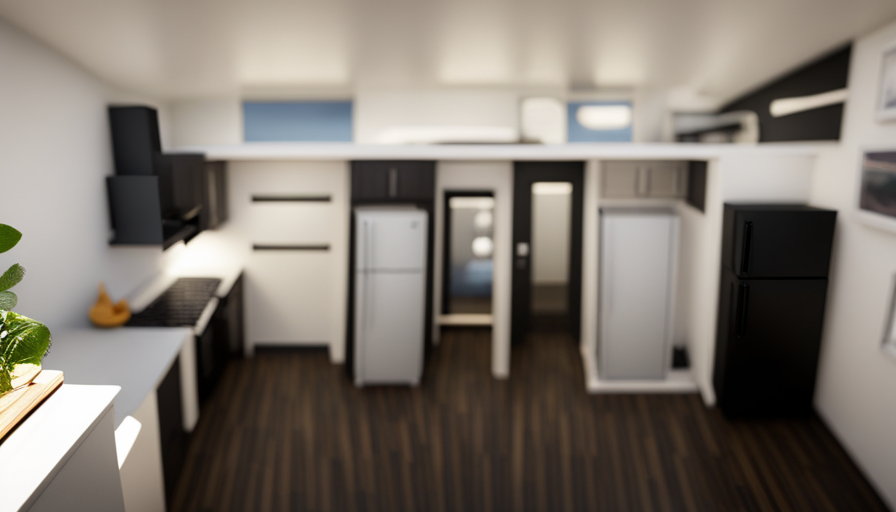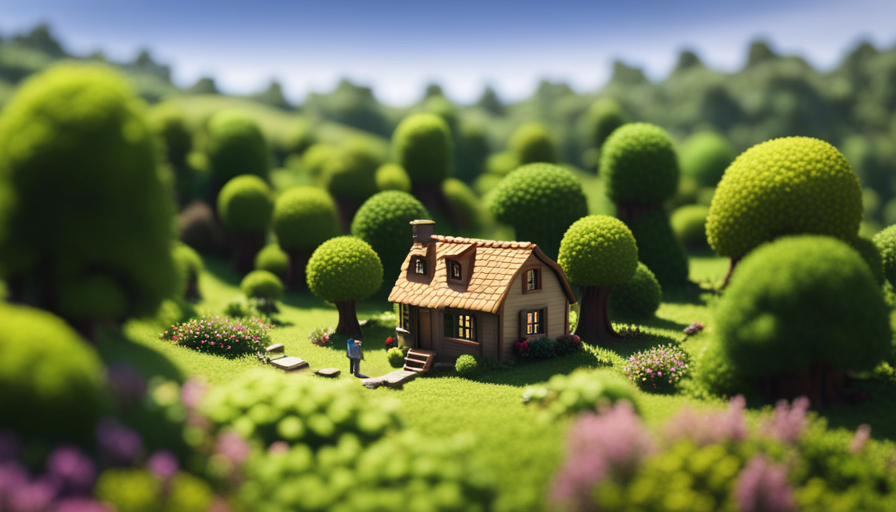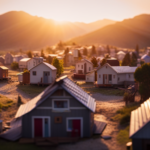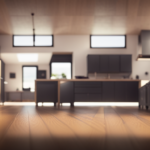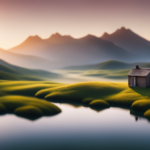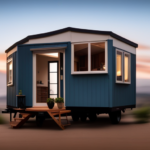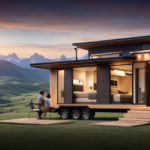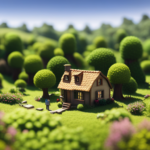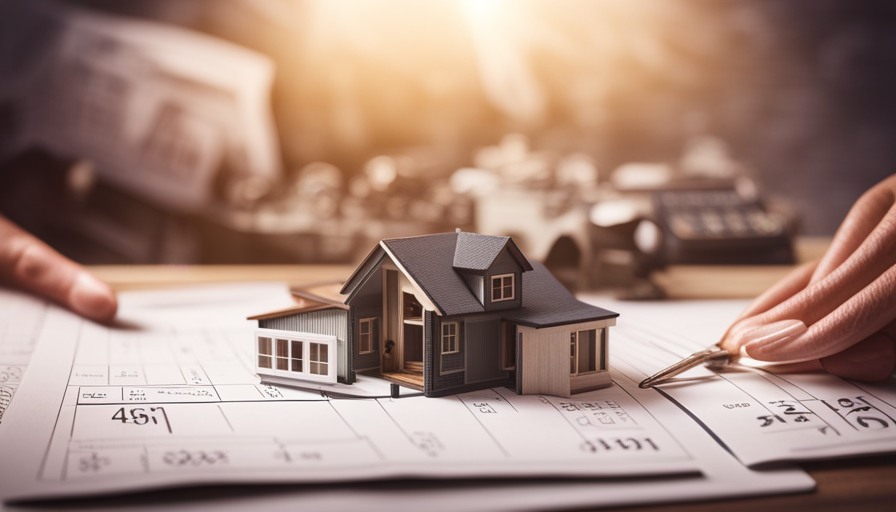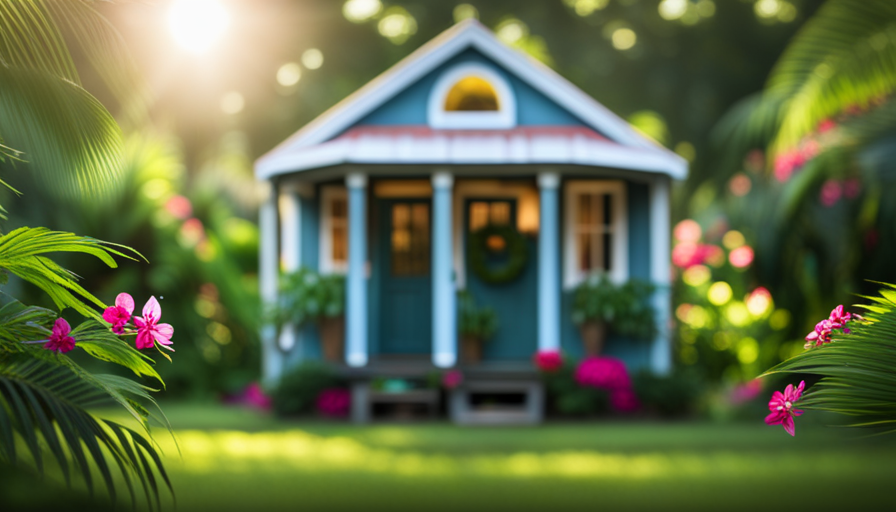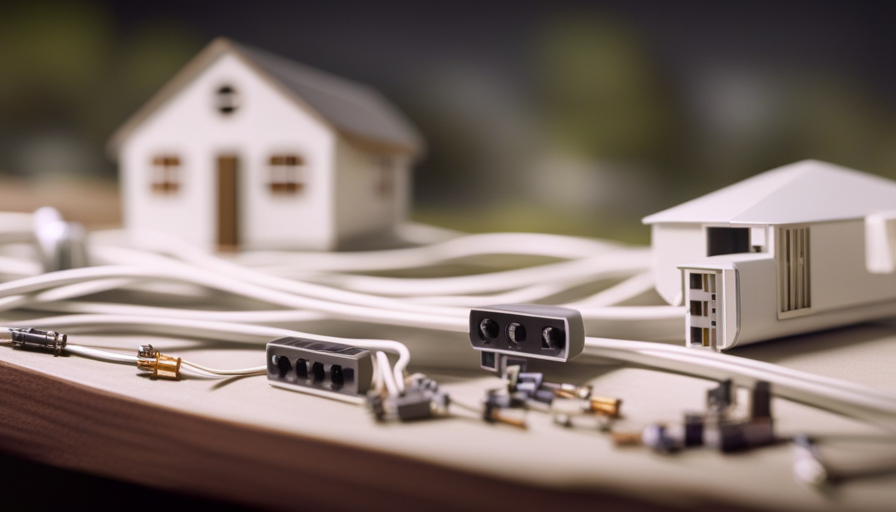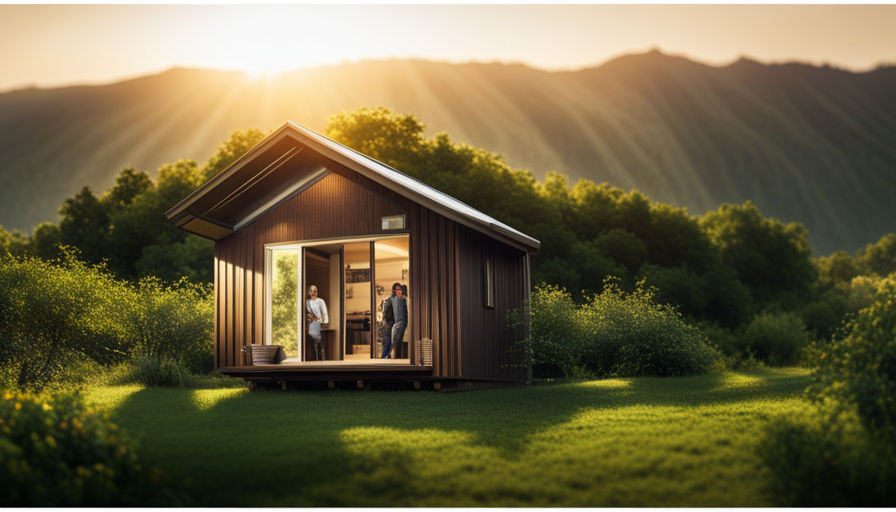Entering a spacious tiny home, I am amazed by the clever use of space and modern design. The Tiny House Movement has been gaining popularity, appealing to those seeking a simpler, environmentally friendly lifestyle. While the idea of a big tiny house may seem contradictory, these compact homes have a surprising way of feeling spacious.
In this article, we will delve into the dimensions and square footage of large tiny houses, exploring the creative design features that maximize every inch. We will discuss the benefits and challenges of living in a large tiny house, and provide real-life examples of beautifully designed homes that showcase the possibilities.
Whether you’re considering downsizing or simply intrigued by the concept, we will help you determine if a large tiny house is the right fit for you. So join me as we embark on a journey into the world of large tiny houses, where size is redefined and possibilities are endless.
Key Takeaways
- Large tiny houses range in size from 300 to 600 square feet, providing more living space compared to traditional tiny houses.
- Layouts of large tiny houses are meticulously planned to maximize space, with creative design features like built-in storage and convertible furniture.
- Living in a large tiny house offers benefits such as more storage options and separate living areas, but it also comes with challenges like higher construction and maintenance costs, and the need to find suitable parking spaces.
- Factors to consider before moving into a large tiny house include family size, lifestyle, budget, and weighing the pros and cons of larger tiny house living.
Understanding the Tiny House Movement
If you’ve ever wondered just how small the tiny houses in the Tiny House Movement can be, you’ll be amazed to learn that even the larger ones are still considered ‘tiny’ by traditional housing standards. The Tiny House Movement is a growing community of people who are choosing to downsize their living spaces in an effort to live more sustainably.
These tiny homes often have a minimal environmental impact due to their small size and efficient use of resources. Despite their diminutive stature, the tiny house community has found creative ways to maximize space and functionality, making these homes surprisingly livable.
However, when it comes to defining the size category of a large tiny house, it’s important to consider factors such as square footage, number of rooms, and overall layout.
Transitioning into the next section, let’s delve into the specifics of what makes a tiny house ‘large’.
Defining the Size Category of a Large Tiny House
Imagine a space so compact, it challenges the very notion of size categories, where every square inch is meticulously designed to maximize functionality and efficiency. Defining the size category of a large tiny house can be subjective, but generally, it refers to tiny houses that are larger than the average tiny house.
Pros of a large tiny house include more living space, room for amenities like a full-size kitchen or bathroom, and the ability to accommodate more people. However, there are also cons to consider, such as higher costs, more maintenance, and potential zoning restrictions.
When exploring the dimensions and square footage of large tiny houses, we delve into the fascinating world of innovative design and creative use of space.
Exploring the Dimensions and Square Footage of Large Tiny Houses
Step inside these compact dwellings and marvel at the clever utilization of space as you navigate through intricately designed nooks and crannies in these miniature abodes. Despite their small size, large tiny houses can still offer ample living space.
The dimensions of these houses typically range from 300 to 600 square feet, allowing for a comfortable living experience. The layout of these homes is meticulously planned to make the most of every square inch. Multi-functional furniture and storage solutions are strategically placed to maximize the usability of each area. High ceilings and strategically placed windows create an illusion of openness and prevent the space from feeling cramped. These houses may also feature loft areas or slide-out sections, further expanding the available living space.
Now, let’s explore the creative design features that maximize space in large tiny houses.
Creative Design Features that Maximize Space in Large Tiny Houses
Despite their compact size, these ingeniously crafted dwellings unfold like a well-choreographed dance, seamlessly integrating multi-purpose furniture and hidden storage solutions to create a harmonious symphony of functionality and style.
Here are three creative design features that maximize space in large tiny houses:
-
Built-in storage: From under-stair cabinets to cleverly designed wall units, large tiny houses make use of every nook and cranny to provide ample storage space. These built-in solutions eliminate the need for bulky furniture and keep the living area clutter-free.
-
Convertible furniture: Large tiny houses often feature furniture that serves multiple functions. For example, a sofa can transform into a bed, or a coffee table can extend to become a dining table. This versatility allows homeowners to optimize their space without sacrificing comfort.
-
Vertical utilization: To make the most of limited floor space, large tiny houses utilize vertical storage. This can include wall-mounted shelves, hanging pots and pans, and even lofted sleeping areas. By utilizing vertical space, homeowners can keep their living areas open and spacious.
With these creative storage solutions and multi-functional furniture, living in a large tiny house becomes a practical and efficient lifestyle choice.
Benefits and Challenges of Living in a Large Tiny House
Living in a spacious tiny home offers unique advantages and challenges that come with maximizing space and functionality.
One of the benefits is the freedom to have more storage options. With a larger tiny house, there’s room for built-in shelves, cabinets, and even a separate closet. This allows for better organization and less clutter.
Another advantage is the ability to have separate living areas. You can have a designated sleeping area, a living room, and even a small office space.
However, the challenges of living in a large tiny house include higher costs for construction and maintenance. Additionally, it may be more difficult to find suitable parking spaces for a larger tiny house.
Despite these challenges, the benefits of a spacious tiny home make it a worthwhile endeavor.
Transitioning into the subsequent section, let’s explore some real-life examples of beautifully designed large tiny houses.
Real-life Examples of Beautifully Designed Large Tiny Houses
Take a peek into these stunningly crafted tiny abodes that are as captivating as a work of art. These beautifully designed large tiny houses showcase the perfect blend of aesthetics and functionality. Despite their small footprint, these homes are meticulously designed to optimize space and provide all the comforts of a traditional house.
From clever storage solutions to multi-purpose furniture, every inch of these houses is utilized efficiently. The interior design is often minimalistic, incorporating clean lines and natural materials to create a sense of serenity and openness. These homes also prioritize natural light, with large windows and skylights that bring the outdoors inside.
With their thoughtful design and attention to detail, these large tiny houses offer a unique and inspiring living experience. As you consider whether a large tiny house is right for you, there are several factors to consider before making the move, such as location, zoning regulations, and your lifestyle needs.
Is a Large Tiny House Right for You? Factors to Consider Before Making the Move
Now that we’ve seen some real-life examples of beautifully designed large tiny houses, let’s delve into whether a large tiny house is the right choice for you.
There are several factors to consider before making the move.
Firstly, think about the size of your family or household. A large tiny house may be suitable if you have multiple occupants, but it may feel cramped if you have a large family or frequent visitors.
Secondly, consider your lifestyle and storage needs. A larger tiny house can offer more storage space, but it also means more cleaning and maintenance.
Thirdly, evaluate your budget and financial capabilities. A larger tiny house generally requires a bigger investment, both in terms of construction and ongoing expenses.
Lastly, contemplate the potential pros and cons of living in a larger tiny house. While it may provide more space and comfort, it could also limit mobility and flexibility.
Taking these factors into account will help you determine if a large tiny house aligns with your needs and preferences.
Frequently Asked Questions
Are there any legal restrictions on living in a large tiny house?
There are legal requirements and zoning regulations that govern living in a large tiny house. These restrictions vary depending on the location and jurisdiction. It is important to research and understand the specific regulations in your area before choosing to live in a large tiny house.
Some common requirements may include minimum square footage, specific placement on the property, and adherence to safety codes. Violating these regulations can result in fines or even eviction.
How much does it cost to build a large tiny house?
To build a large tiny house, the cost breakdown can vary depending on whether you choose to do it yourself or hire professionals. DIY builds typically cost around $20,000 to $50,000, with materials being the main expense.
Professional builds, on the other hand, can range from $50,000 to $150,000 or more, considering labor costs and higher quality finishes.
It’s important to carefully consider your budget and desired level of customization when deciding between DIY and professional options.
Can large tiny houses be self-sustainable?
Large tiny houses can indeed be self-sustainable, but they come with their own set of challenges. Achieving self-sustainability requires careful planning and integration of various systems. These systems include solar panels, rainwater harvesting, and composting toilets.
The benefits of self-sustaining large tiny houses are numerous. They include reduced reliance on external resources, lower carbon footprint, and the ability to live off-grid. However, it’s important to consider the initial costs, maintenance requirements, and potential limitations of such systems.
What are the common challenges people face when living in a large tiny house?
Living in a large tiny house presents common challenges that require efficient space management.
How can one make the most of limited square footage? First, it’s crucial to carefully plan the layout, ensuring every inch is maximized.
Second, storage solutions are key to keeping belongings organized and easily accessible.
Lastly, maintaining a clutter-free environment is essential to avoid feeling cramped.
By addressing these challenges, living in a large tiny house can be both comfortable and practical.
Are there any financing options available for purchasing a large tiny house?
There are several financing options available for purchasing a large tiny house. Pros include the ability to own a spacious yet compact home and the potential for cost savings compared to traditional housing. However, there are cons to consider as well, such as the difficulty in finding lenders who specialize in tiny house financing and the limited resale market.
It’s important to thoroughly research and compare options to find the best financing solution for your specific needs.
Conclusion
In conclusion, after delving into the world of large tiny houses, it’s evident that they offer a unique and efficient living solution for those seeking a minimalist lifestyle.
From their dimensions and square footage to their ingenious design features, large tiny houses prove that size doesn’t always equate to comfort.
However, as with any housing option, there are both benefits and challenges to consider before making the move.
Ultimately, whether a large tiny house is right for you depends on your individual needs and preferences. So, before taking the plunge, carefully weigh all the factors at play and ensure it’s a perfect fit for your lifestyle.
After all, as the saying goes, "Measure twice, cut once."
Hi, I’m Emma. I’m the Editor in Chief of Tiny House 43, a blog all about tiny houses. While tree houses are often associated with childhood, they can be the perfect adult retreat. They offer a cozy space to relax and unwind, surrounded by nature. And since they’re typically built on stilts or raised platforms, they offer stunning views that traditional homes simply can’t match. If you’re looking for a unique and romantic getaway, a tree house tiny house might just be the perfect option.
